FIN5FSA La Trobe University: Domino's Pizza Financial Analysis
VerifiedAdded on 2023/03/23
|17
|2527
|41
Report
AI Summary
This report provides a comprehensive financial statement analysis of Domino's Pizza Enterprises Ltd. covering a ten-year period. It utilizes common size financial statements, horizontal analysis, and cash flow analysis to evaluate the company's financial performance and position. The analysis incl...
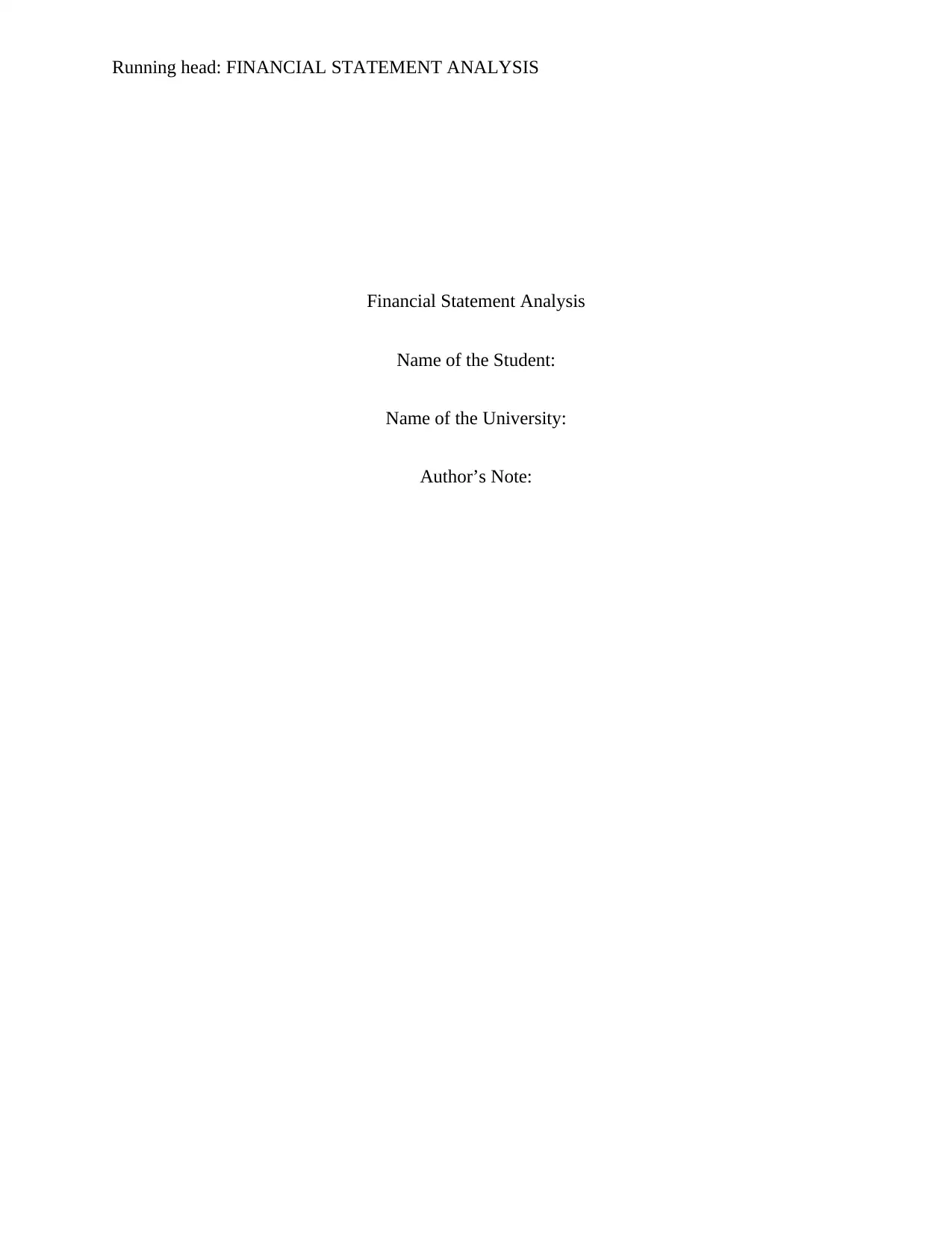
Running head: FINANCIAL STATEMENT ANALYSIS
Financial Statement Analysis
Name of the Student:
Name of the University:
Author’s Note:
Financial Statement Analysis
Name of the Student:
Name of the University:
Author’s Note:
Paraphrase This Document
Need a fresh take? Get an instant paraphrase of this document with our AI Paraphraser
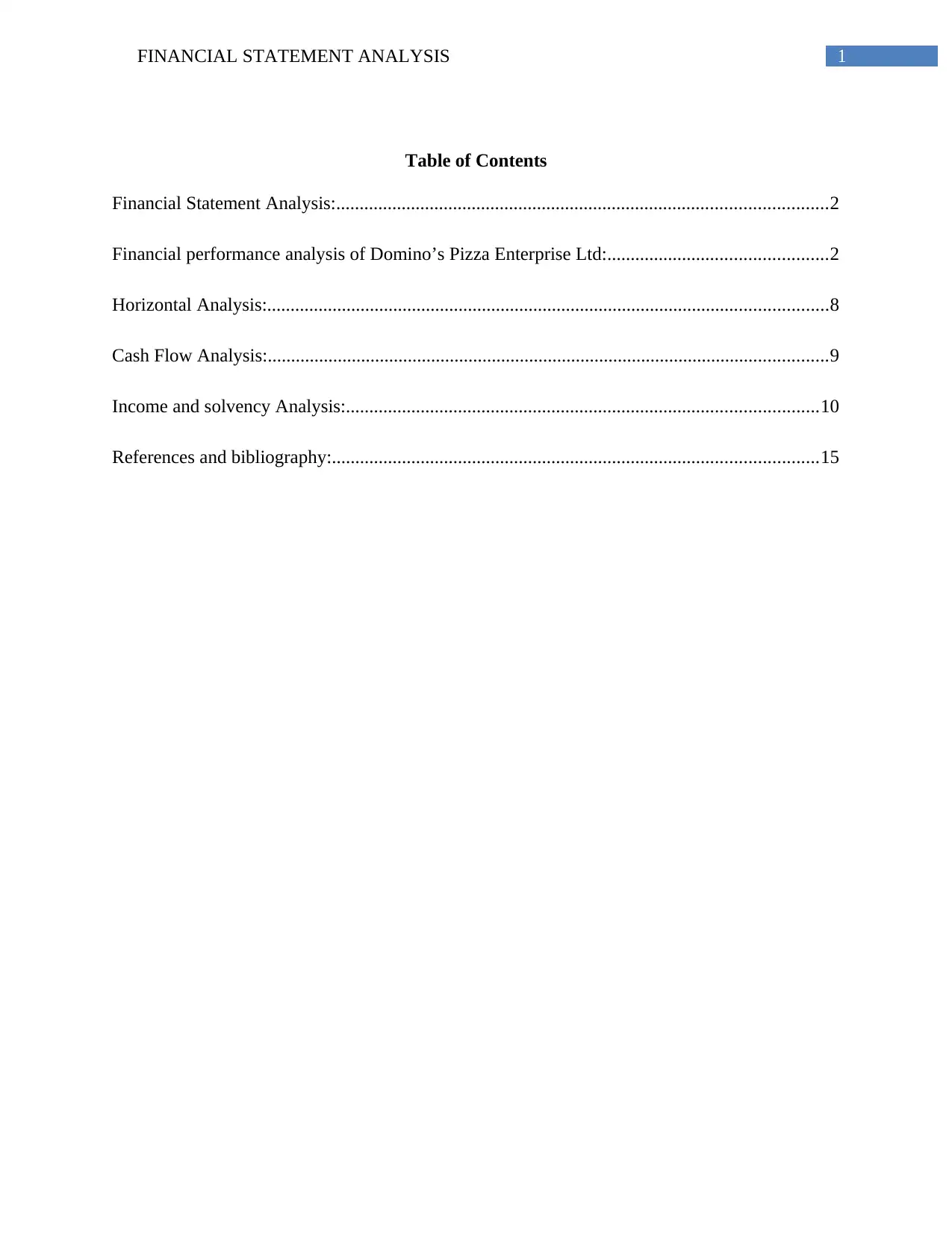
1FINANCIAL STATEMENT ANALYSIS
Table of Contents
Financial Statement Analysis:.........................................................................................................2
Financial performance analysis of Domino’s Pizza Enterprise Ltd:...............................................2
Horizontal Analysis:........................................................................................................................8
Cash Flow Analysis:........................................................................................................................9
Income and solvency Analysis:.....................................................................................................10
References and bibliography:........................................................................................................15
Table of Contents
Financial Statement Analysis:.........................................................................................................2
Financial performance analysis of Domino’s Pizza Enterprise Ltd:...............................................2
Horizontal Analysis:........................................................................................................................8
Cash Flow Analysis:........................................................................................................................9
Income and solvency Analysis:.....................................................................................................10
References and bibliography:........................................................................................................15
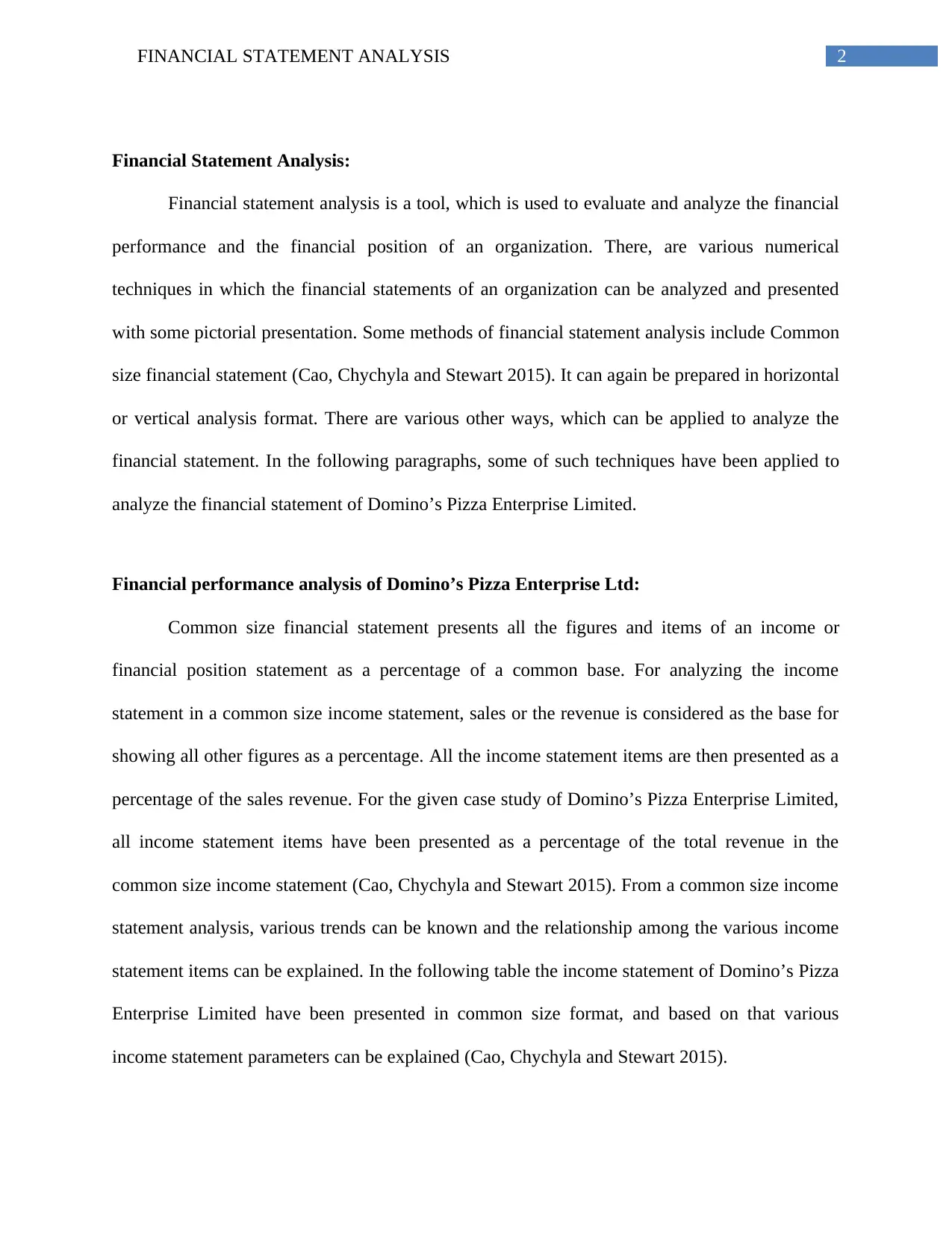
2FINANCIAL STATEMENT ANALYSIS
Financial Statement Analysis:
Financial statement analysis is a tool, which is used to evaluate and analyze the financial
performance and the financial position of an organization. There, are various numerical
techniques in which the financial statements of an organization can be analyzed and presented
with some pictorial presentation. Some methods of financial statement analysis include Common
size financial statement (Cao, Chychyla and Stewart 2015). It can again be prepared in horizontal
or vertical analysis format. There are various other ways, which can be applied to analyze the
financial statement. In the following paragraphs, some of such techniques have been applied to
analyze the financial statement of Domino’s Pizza Enterprise Limited.
Financial performance analysis of Domino’s Pizza Enterprise Ltd:
Common size financial statement presents all the figures and items of an income or
financial position statement as a percentage of a common base. For analyzing the income
statement in a common size income statement, sales or the revenue is considered as the base for
showing all other figures as a percentage. All the income statement items are then presented as a
percentage of the sales revenue. For the given case study of Domino’s Pizza Enterprise Limited,
all income statement items have been presented as a percentage of the total revenue in the
common size income statement (Cao, Chychyla and Stewart 2015). From a common size income
statement analysis, various trends can be known and the relationship among the various income
statement items can be explained. In the following table the income statement of Domino’s Pizza
Enterprise Limited have been presented in common size format, and based on that various
income statement parameters can be explained (Cao, Chychyla and Stewart 2015).
Financial Statement Analysis:
Financial statement analysis is a tool, which is used to evaluate and analyze the financial
performance and the financial position of an organization. There, are various numerical
techniques in which the financial statements of an organization can be analyzed and presented
with some pictorial presentation. Some methods of financial statement analysis include Common
size financial statement (Cao, Chychyla and Stewart 2015). It can again be prepared in horizontal
or vertical analysis format. There are various other ways, which can be applied to analyze the
financial statement. In the following paragraphs, some of such techniques have been applied to
analyze the financial statement of Domino’s Pizza Enterprise Limited.
Financial performance analysis of Domino’s Pizza Enterprise Ltd:
Common size financial statement presents all the figures and items of an income or
financial position statement as a percentage of a common base. For analyzing the income
statement in a common size income statement, sales or the revenue is considered as the base for
showing all other figures as a percentage. All the income statement items are then presented as a
percentage of the sales revenue. For the given case study of Domino’s Pizza Enterprise Limited,
all income statement items have been presented as a percentage of the total revenue in the
common size income statement (Cao, Chychyla and Stewart 2015). From a common size income
statement analysis, various trends can be known and the relationship among the various income
statement items can be explained. In the following table the income statement of Domino’s Pizza
Enterprise Limited have been presented in common size format, and based on that various
income statement parameters can be explained (Cao, Chychyla and Stewart 2015).
⊘ This is a preview!⊘
Do you want full access?
Subscribe today to unlock all pages.

Trusted by 1+ million students worldwide
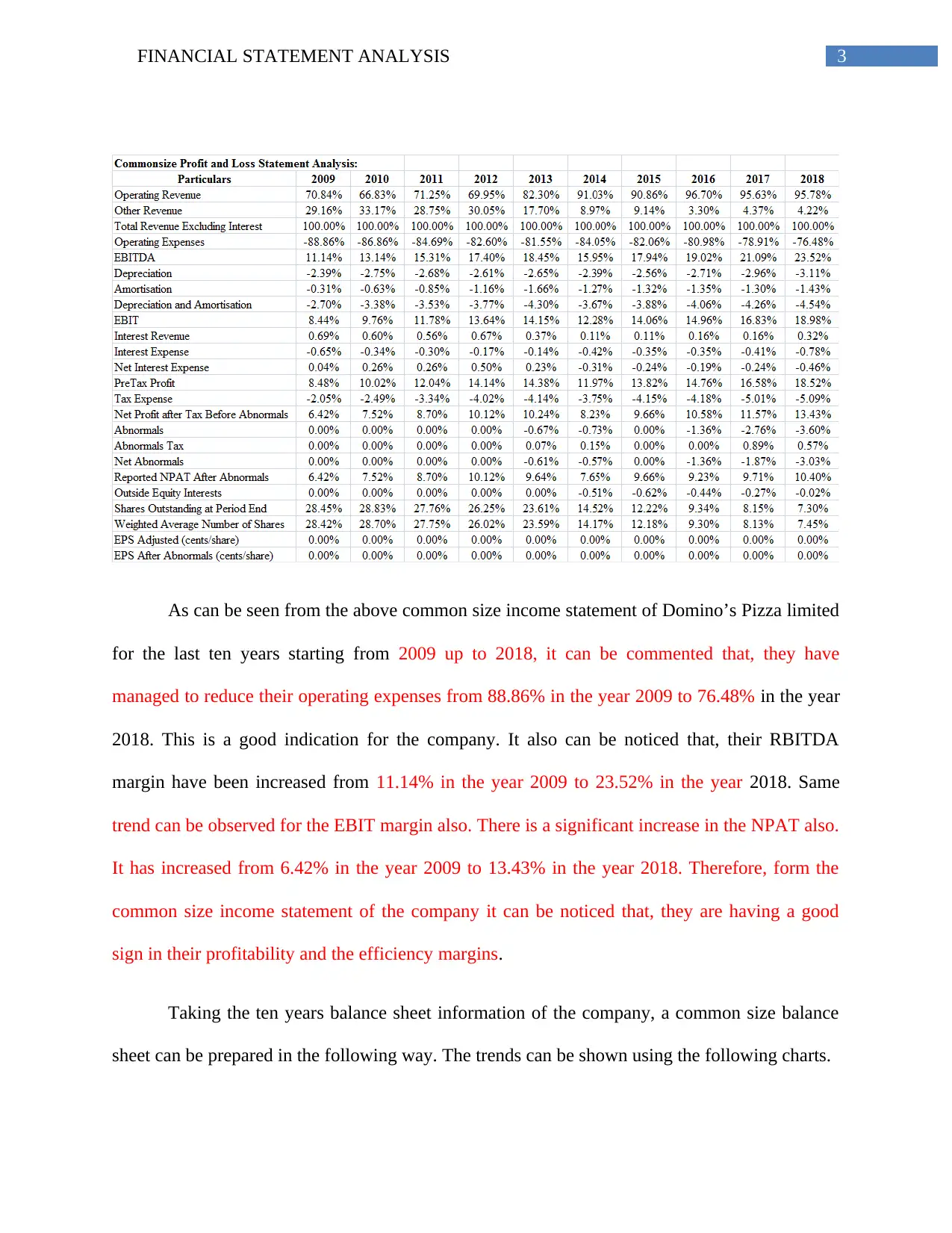
3FINANCIAL STATEMENT ANALYSIS
As can be seen from the above common size income statement of Domino’s Pizza limited
for the last ten years starting from 2009 up to 2018, it can be commented that, they have
managed to reduce their operating expenses from 88.86% in the year 2009 to 76.48% in the year
2018. This is a good indication for the company. It also can be noticed that, their RBITDA
margin have been increased from 11.14% in the year 2009 to 23.52% in the year 2018. Same
trend can be observed for the EBIT margin also. There is a significant increase in the NPAT also.
It has increased from 6.42% in the year 2009 to 13.43% in the year 2018. Therefore, form the
common size income statement of the company it can be noticed that, they are having a good
sign in their profitability and the efficiency margins.
Taking the ten years balance sheet information of the company, a common size balance
sheet can be prepared in the following way. The trends can be shown using the following charts.
As can be seen from the above common size income statement of Domino’s Pizza limited
for the last ten years starting from 2009 up to 2018, it can be commented that, they have
managed to reduce their operating expenses from 88.86% in the year 2009 to 76.48% in the year
2018. This is a good indication for the company. It also can be noticed that, their RBITDA
margin have been increased from 11.14% in the year 2009 to 23.52% in the year 2018. Same
trend can be observed for the EBIT margin also. There is a significant increase in the NPAT also.
It has increased from 6.42% in the year 2009 to 13.43% in the year 2018. Therefore, form the
common size income statement of the company it can be noticed that, they are having a good
sign in their profitability and the efficiency margins.
Taking the ten years balance sheet information of the company, a common size balance
sheet can be prepared in the following way. The trends can be shown using the following charts.
Paraphrase This Document
Need a fresh take? Get an instant paraphrase of this document with our AI Paraphraser
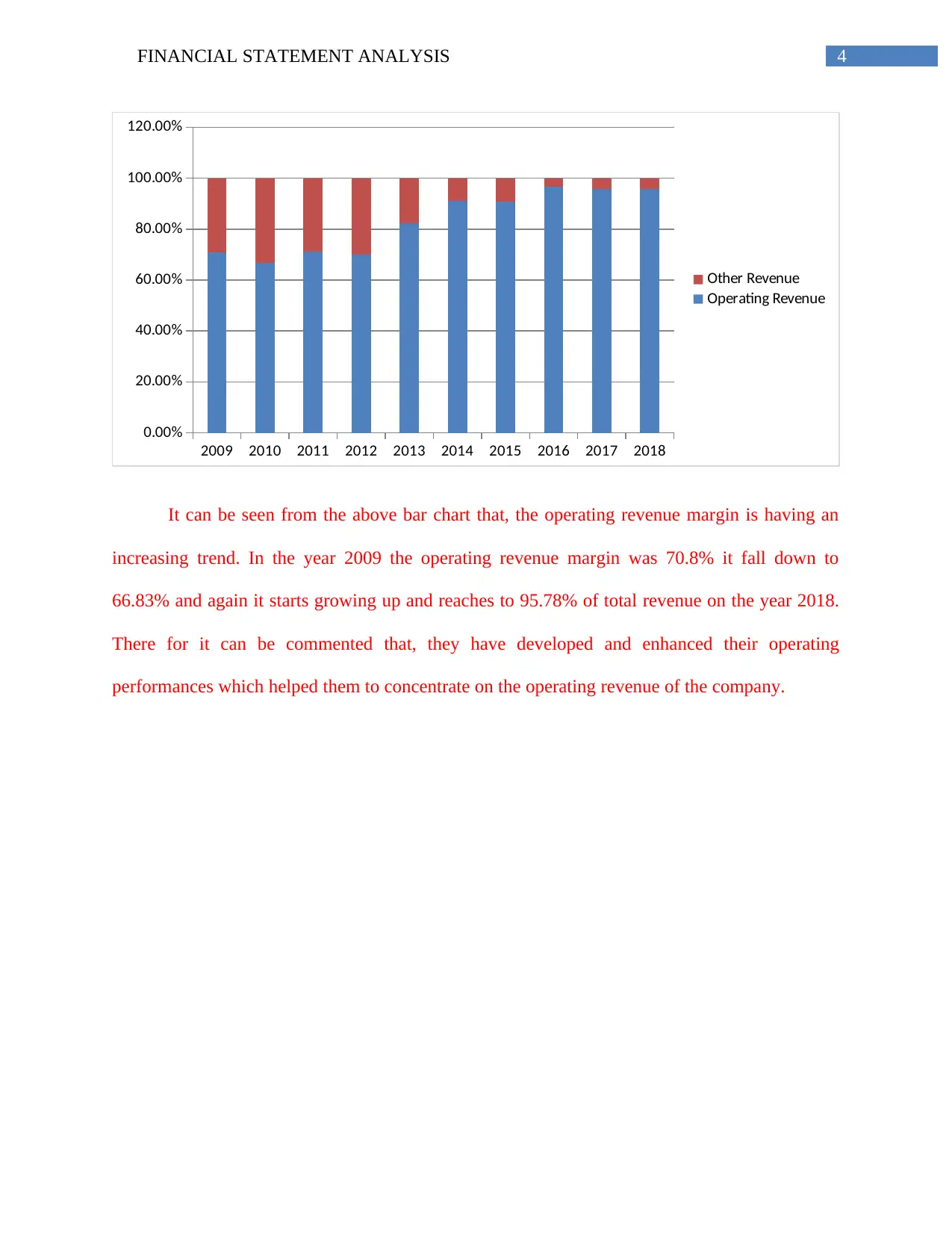
4FINANCIAL STATEMENT ANALYSIS
2009 2010 2011 2012 2013 2014 2015 2016 2017 2018
0.00%
20.00%
40.00%
60.00%
80.00%
100.00%
120.00%
Other Revenue
Operating Revenue
It can be seen from the above bar chart that, the operating revenue margin is having an
increasing trend. In the year 2009 the operating revenue margin was 70.8% it fall down to
66.83% and again it starts growing up and reaches to 95.78% of total revenue on the year 2018.
There for it can be commented that, they have developed and enhanced their operating
performances which helped them to concentrate on the operating revenue of the company.
2009 2010 2011 2012 2013 2014 2015 2016 2017 2018
0.00%
20.00%
40.00%
60.00%
80.00%
100.00%
120.00%
Other Revenue
Operating Revenue
It can be seen from the above bar chart that, the operating revenue margin is having an
increasing trend. In the year 2009 the operating revenue margin was 70.8% it fall down to
66.83% and again it starts growing up and reaches to 95.78% of total revenue on the year 2018.
There for it can be commented that, they have developed and enhanced their operating
performances which helped them to concentrate on the operating revenue of the company.
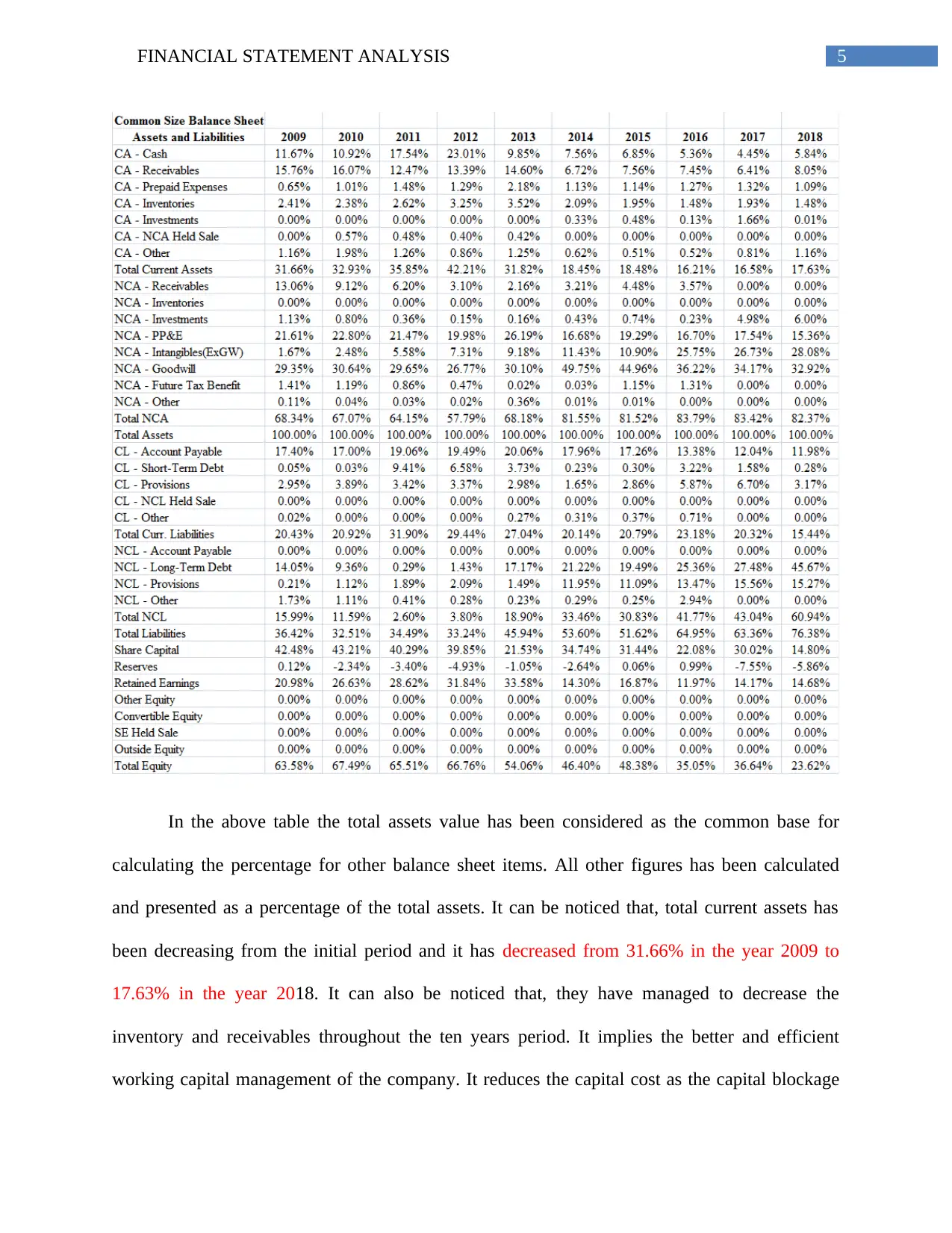
5FINANCIAL STATEMENT ANALYSIS
In the above table the total assets value has been considered as the common base for
calculating the percentage for other balance sheet items. All other figures has been calculated
and presented as a percentage of the total assets. It can be noticed that, total current assets has
been decreasing from the initial period and it has decreased from 31.66% in the year 2009 to
17.63% in the year 2018. It can also be noticed that, they have managed to decrease the
inventory and receivables throughout the ten years period. It implies the better and efficient
working capital management of the company. It reduces the capital cost as the capital blockage
In the above table the total assets value has been considered as the common base for
calculating the percentage for other balance sheet items. All other figures has been calculated
and presented as a percentage of the total assets. It can be noticed that, total current assets has
been decreasing from the initial period and it has decreased from 31.66% in the year 2009 to
17.63% in the year 2018. It can also be noticed that, they have managed to decrease the
inventory and receivables throughout the ten years period. It implies the better and efficient
working capital management of the company. It reduces the capital cost as the capital blockage
⊘ This is a preview!⊘
Do you want full access?
Subscribe today to unlock all pages.

Trusted by 1+ million students worldwide
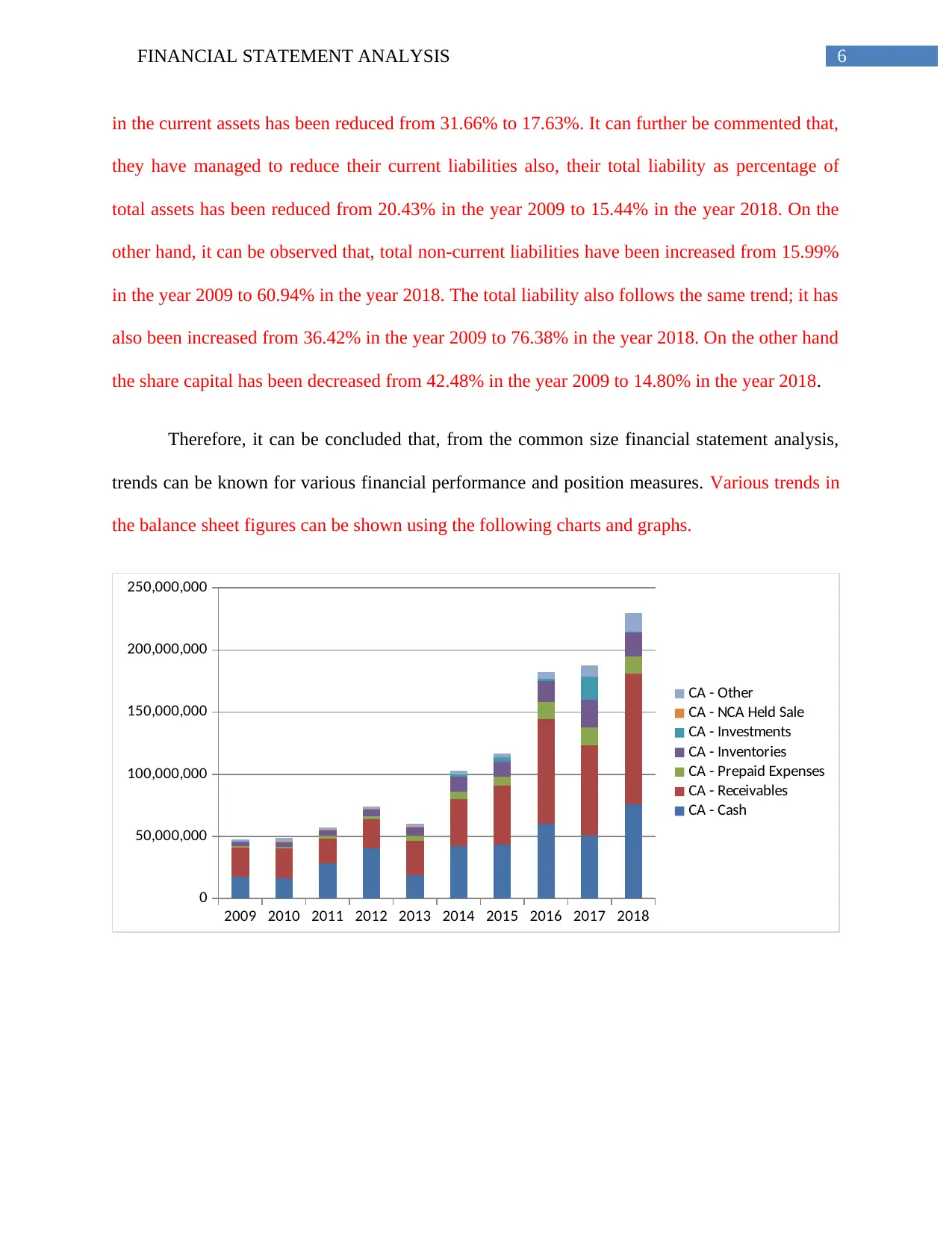
6FINANCIAL STATEMENT ANALYSIS
in the current assets has been reduced from 31.66% to 17.63%. It can further be commented that,
they have managed to reduce their current liabilities also, their total liability as percentage of
total assets has been reduced from 20.43% in the year 2009 to 15.44% in the year 2018. On the
other hand, it can be observed that, total non-current liabilities have been increased from 15.99%
in the year 2009 to 60.94% in the year 2018. The total liability also follows the same trend; it has
also been increased from 36.42% in the year 2009 to 76.38% in the year 2018. On the other hand
the share capital has been decreased from 42.48% in the year 2009 to 14.80% in the year 2018.
Therefore, it can be concluded that, from the common size financial statement analysis,
trends can be known for various financial performance and position measures. Various trends in
the balance sheet figures can be shown using the following charts and graphs.
2009 2010 2011 2012 2013 2014 2015 2016 2017 2018
0
50,000,000
100,000,000
150,000,000
200,000,000
250,000,000
CA - Other
CA - NCA Held Sale
CA - Investments
CA - Inventories
CA - Prepaid Expenses
CA - Receivables
CA - Cash
in the current assets has been reduced from 31.66% to 17.63%. It can further be commented that,
they have managed to reduce their current liabilities also, their total liability as percentage of
total assets has been reduced from 20.43% in the year 2009 to 15.44% in the year 2018. On the
other hand, it can be observed that, total non-current liabilities have been increased from 15.99%
in the year 2009 to 60.94% in the year 2018. The total liability also follows the same trend; it has
also been increased from 36.42% in the year 2009 to 76.38% in the year 2018. On the other hand
the share capital has been decreased from 42.48% in the year 2009 to 14.80% in the year 2018.
Therefore, it can be concluded that, from the common size financial statement analysis,
trends can be known for various financial performance and position measures. Various trends in
the balance sheet figures can be shown using the following charts and graphs.
2009 2010 2011 2012 2013 2014 2015 2016 2017 2018
0
50,000,000
100,000,000
150,000,000
200,000,000
250,000,000
CA - Other
CA - NCA Held Sale
CA - Investments
CA - Inventories
CA - Prepaid Expenses
CA - Receivables
CA - Cash
Paraphrase This Document
Need a fresh take? Get an instant paraphrase of this document with our AI Paraphraser

7FINANCIAL STATEMENT ANALYSIS
2009 2010 2011 2012 2013 2014 2015 2016 2017 2018
0
200,000,000
400,000,000
600,000,000
800,000,000
1,000,000,000
1,200,000,000
1,400,000,000
Total Assets
Total Liabilities
It can be observed that with the increase in total assets of the company the total liabilities
have also been increased. This is because of additional debt financing for funding the acquisition
of fixed assets.
2009 2010 2011 2012 2013 2014 2015 2016 2017 2018
0%
10%
20%
30%
40%
50%
60%
70%
80%
90%
100%
Total Equity
Total Liabilities
Total Assets
From the above graph their total assets backing can be easily observed. Initially their
assets were mostly backed by equity financing later on the debt capital increased significantly.
2009 2010 2011 2012 2013 2014 2015 2016 2017 2018
0
200,000,000
400,000,000
600,000,000
800,000,000
1,000,000,000
1,200,000,000
1,400,000,000
Total Assets
Total Liabilities
It can be observed that with the increase in total assets of the company the total liabilities
have also been increased. This is because of additional debt financing for funding the acquisition
of fixed assets.
2009 2010 2011 2012 2013 2014 2015 2016 2017 2018
0%
10%
20%
30%
40%
50%
60%
70%
80%
90%
100%
Total Equity
Total Liabilities
Total Assets
From the above graph their total assets backing can be easily observed. Initially their
assets were mostly backed by equity financing later on the debt capital increased significantly.
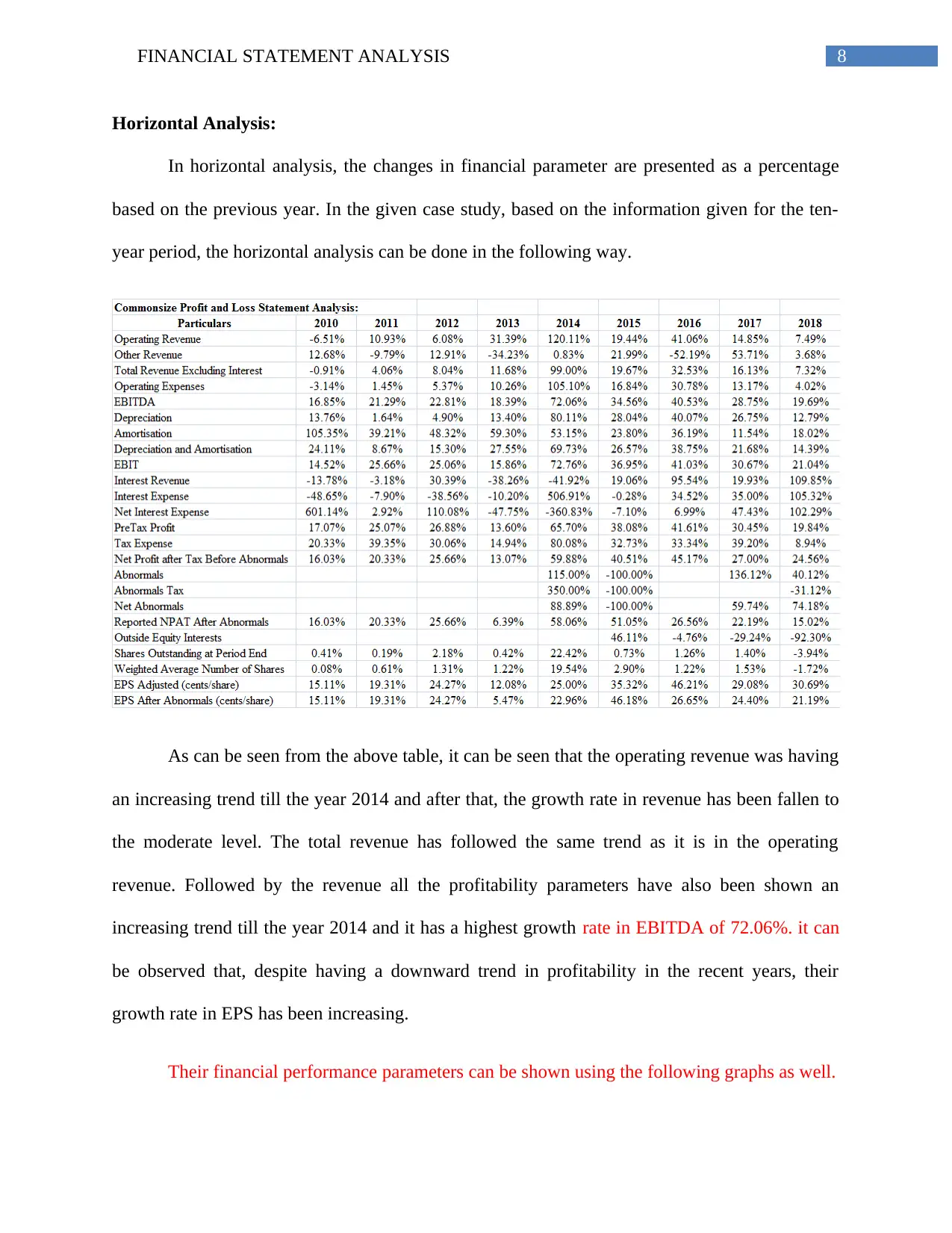
8FINANCIAL STATEMENT ANALYSIS
Horizontal Analysis:
In horizontal analysis, the changes in financial parameter are presented as a percentage
based on the previous year. In the given case study, based on the information given for the ten-
year period, the horizontal analysis can be done in the following way.
As can be seen from the above table, it can be seen that the operating revenue was having
an increasing trend till the year 2014 and after that, the growth rate in revenue has been fallen to
the moderate level. The total revenue has followed the same trend as it is in the operating
revenue. Followed by the revenue all the profitability parameters have also been shown an
increasing trend till the year 2014 and it has a highest growth rate in EBITDA of 72.06%. it can
be observed that, despite having a downward trend in profitability in the recent years, their
growth rate in EPS has been increasing.
Their financial performance parameters can be shown using the following graphs as well.
Horizontal Analysis:
In horizontal analysis, the changes in financial parameter are presented as a percentage
based on the previous year. In the given case study, based on the information given for the ten-
year period, the horizontal analysis can be done in the following way.
As can be seen from the above table, it can be seen that the operating revenue was having
an increasing trend till the year 2014 and after that, the growth rate in revenue has been fallen to
the moderate level. The total revenue has followed the same trend as it is in the operating
revenue. Followed by the revenue all the profitability parameters have also been shown an
increasing trend till the year 2014 and it has a highest growth rate in EBITDA of 72.06%. it can
be observed that, despite having a downward trend in profitability in the recent years, their
growth rate in EPS has been increasing.
Their financial performance parameters can be shown using the following graphs as well.
⊘ This is a preview!⊘
Do you want full access?
Subscribe today to unlock all pages.

Trusted by 1+ million students worldwide
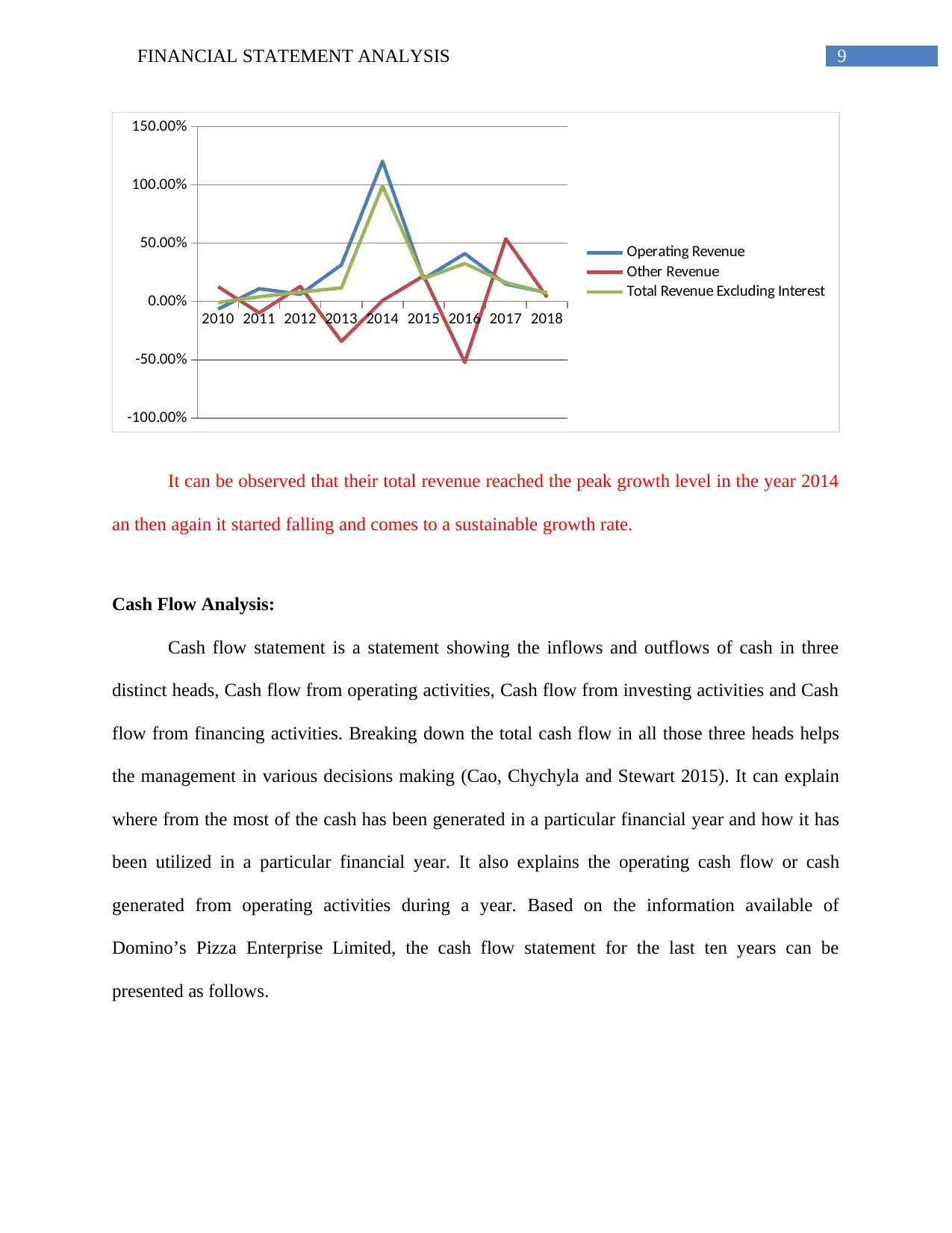
9FINANCIAL STATEMENT ANALYSIS
2010 2011 2012 2013 2014 2015 2016 2017 2018
-100.00%
-50.00%
0.00%
50.00%
100.00%
150.00%
Operating Revenue
Other Revenue
Total Revenue Excluding Interest
It can be observed that their total revenue reached the peak growth level in the year 2014
an then again it started falling and comes to a sustainable growth rate.
Cash Flow Analysis:
Cash flow statement is a statement showing the inflows and outflows of cash in three
distinct heads, Cash flow from operating activities, Cash flow from investing activities and Cash
flow from financing activities. Breaking down the total cash flow in all those three heads helps
the management in various decisions making (Cao, Chychyla and Stewart 2015). It can explain
where from the most of the cash has been generated in a particular financial year and how it has
been utilized in a particular financial year. It also explains the operating cash flow or cash
generated from operating activities during a year. Based on the information available of
Domino’s Pizza Enterprise Limited, the cash flow statement for the last ten years can be
presented as follows.
2010 2011 2012 2013 2014 2015 2016 2017 2018
-100.00%
-50.00%
0.00%
50.00%
100.00%
150.00%
Operating Revenue
Other Revenue
Total Revenue Excluding Interest
It can be observed that their total revenue reached the peak growth level in the year 2014
an then again it started falling and comes to a sustainable growth rate.
Cash Flow Analysis:
Cash flow statement is a statement showing the inflows and outflows of cash in three
distinct heads, Cash flow from operating activities, Cash flow from investing activities and Cash
flow from financing activities. Breaking down the total cash flow in all those three heads helps
the management in various decisions making (Cao, Chychyla and Stewart 2015). It can explain
where from the most of the cash has been generated in a particular financial year and how it has
been utilized in a particular financial year. It also explains the operating cash flow or cash
generated from operating activities during a year. Based on the information available of
Domino’s Pizza Enterprise Limited, the cash flow statement for the last ten years can be
presented as follows.
Paraphrase This Document
Need a fresh take? Get an instant paraphrase of this document with our AI Paraphraser
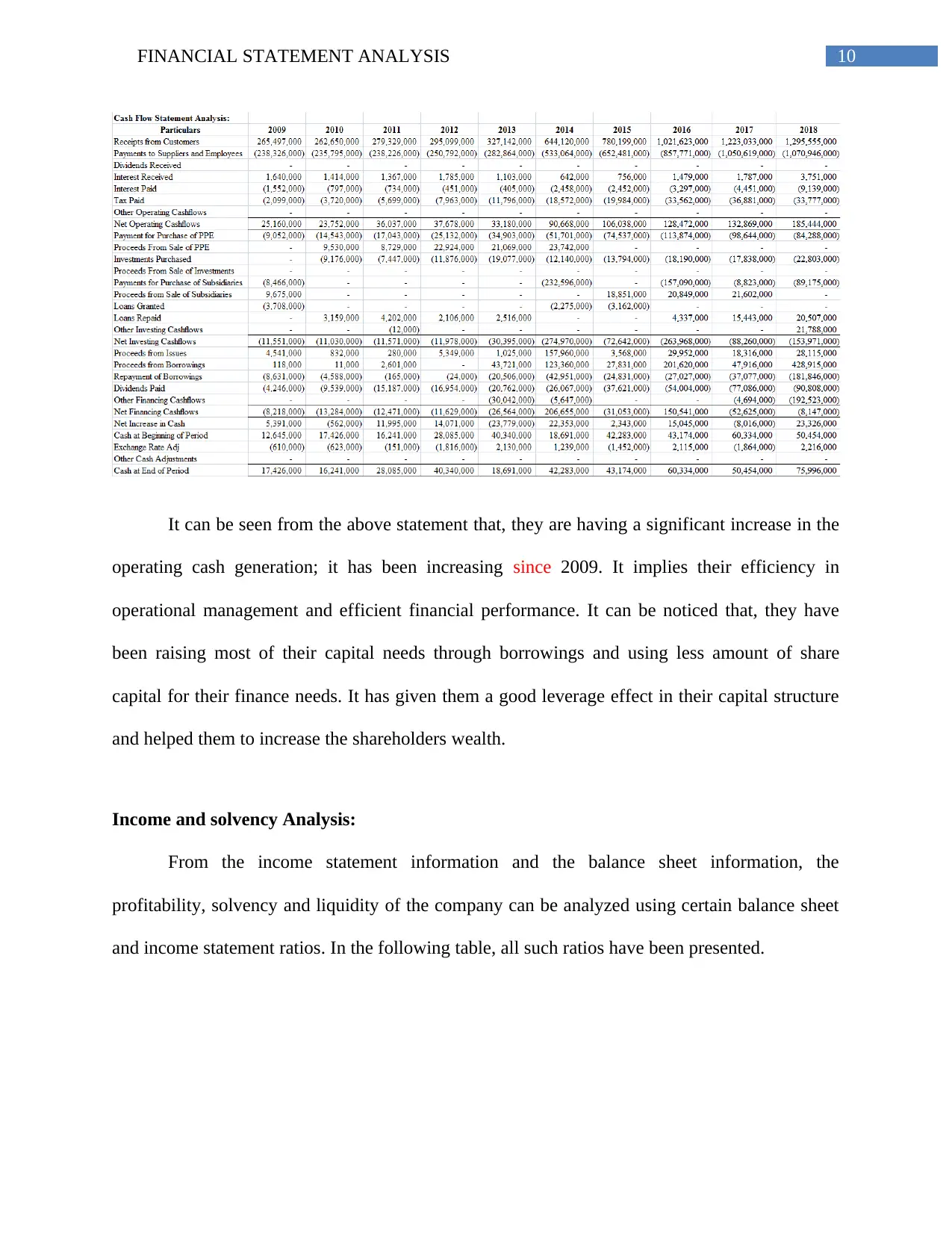
10FINANCIAL STATEMENT ANALYSIS
It can be seen from the above statement that, they are having a significant increase in the
operating cash generation; it has been increasing since 2009. It implies their efficiency in
operational management and efficient financial performance. It can be noticed that, they have
been raising most of their capital needs through borrowings and using less amount of share
capital for their finance needs. It has given them a good leverage effect in their capital structure
and helped them to increase the shareholders wealth.
Income and solvency Analysis:
From the income statement information and the balance sheet information, the
profitability, solvency and liquidity of the company can be analyzed using certain balance sheet
and income statement ratios. In the following table, all such ratios have been presented.
It can be seen from the above statement that, they are having a significant increase in the
operating cash generation; it has been increasing since 2009. It implies their efficiency in
operational management and efficient financial performance. It can be noticed that, they have
been raising most of their capital needs through borrowings and using less amount of share
capital for their finance needs. It has given them a good leverage effect in their capital structure
and helped them to increase the shareholders wealth.
Income and solvency Analysis:
From the income statement information and the balance sheet information, the
profitability, solvency and liquidity of the company can be analyzed using certain balance sheet
and income statement ratios. In the following table, all such ratios have been presented.
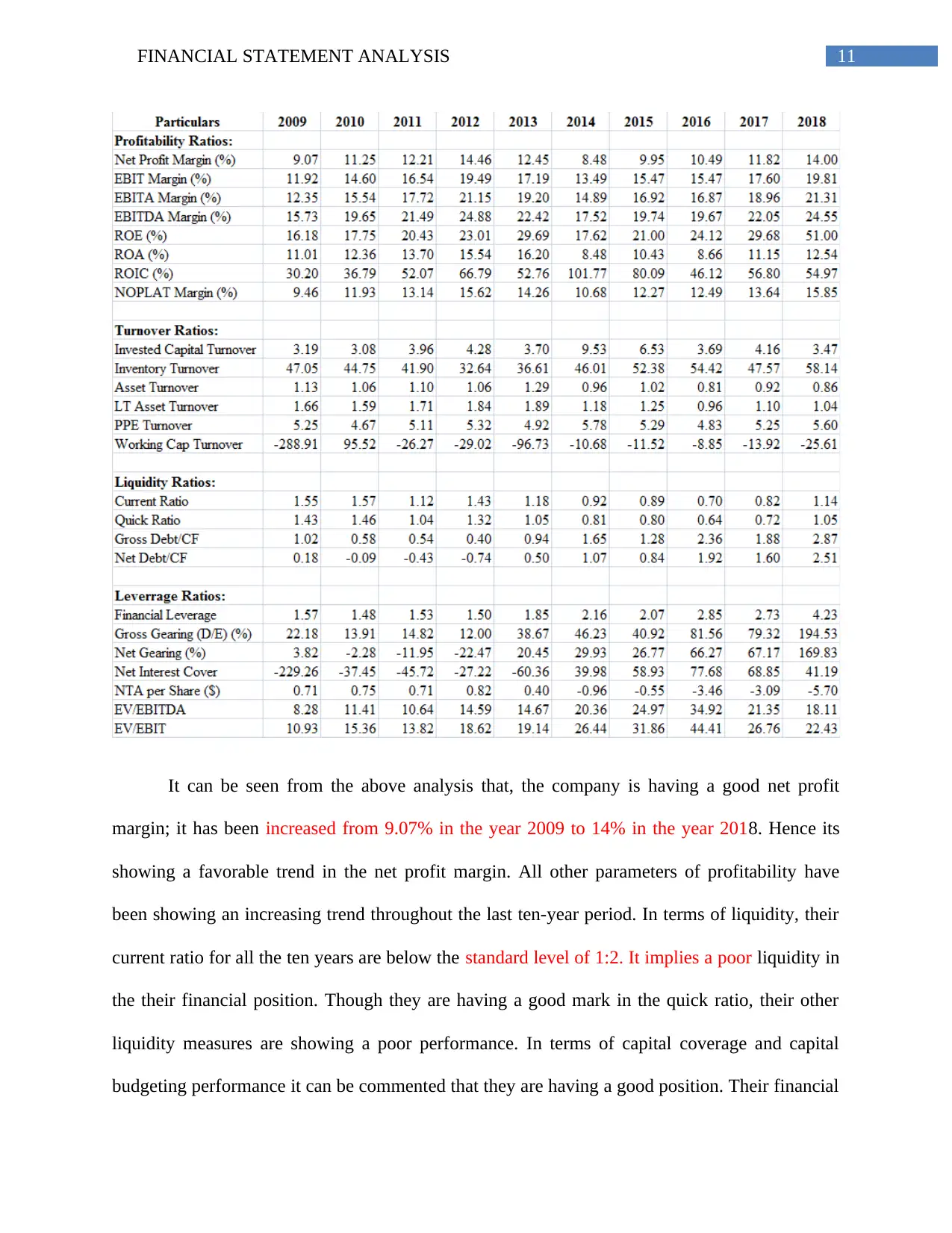
11FINANCIAL STATEMENT ANALYSIS
It can be seen from the above analysis that, the company is having a good net profit
margin; it has been increased from 9.07% in the year 2009 to 14% in the year 2018. Hence its
showing a favorable trend in the net profit margin. All other parameters of profitability have
been showing an increasing trend throughout the last ten-year period. In terms of liquidity, their
current ratio for all the ten years are below the standard level of 1:2. It implies a poor liquidity in
the their financial position. Though they are having a good mark in the quick ratio, their other
liquidity measures are showing a poor performance. In terms of capital coverage and capital
budgeting performance it can be commented that they are having a good position. Their financial
It can be seen from the above analysis that, the company is having a good net profit
margin; it has been increased from 9.07% in the year 2009 to 14% in the year 2018. Hence its
showing a favorable trend in the net profit margin. All other parameters of profitability have
been showing an increasing trend throughout the last ten-year period. In terms of liquidity, their
current ratio for all the ten years are below the standard level of 1:2. It implies a poor liquidity in
the their financial position. Though they are having a good mark in the quick ratio, their other
liquidity measures are showing a poor performance. In terms of capital coverage and capital
budgeting performance it can be commented that they are having a good position. Their financial
⊘ This is a preview!⊘
Do you want full access?
Subscribe today to unlock all pages.

Trusted by 1+ million students worldwide
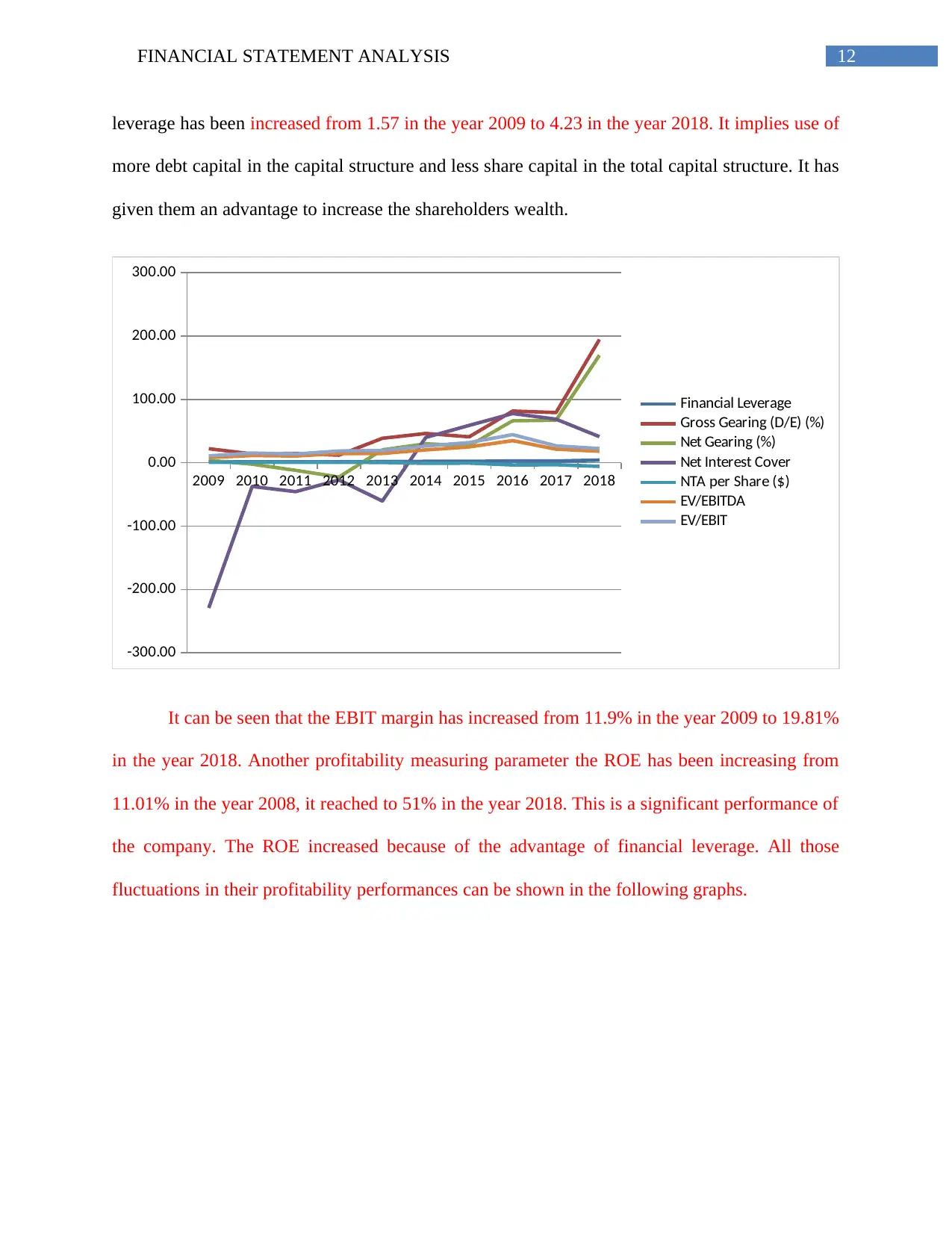
12FINANCIAL STATEMENT ANALYSIS
leverage has been increased from 1.57 in the year 2009 to 4.23 in the year 2018. It implies use of
more debt capital in the capital structure and less share capital in the total capital structure. It has
given them an advantage to increase the shareholders wealth.
2009 2010 2011 2012 2013 2014 2015 2016 2017 2018
-300.00
-200.00
-100.00
0.00
100.00
200.00
300.00
Financial Leverage
Gross Gearing (D/E) (%)
Net Gearing (%)
Net Interest Cover
NTA per Share ($)
EV/EBITDA
EV/EBIT
It can be seen that the EBIT margin has increased from 11.9% in the year 2009 to 19.81%
in the year 2018. Another profitability measuring parameter the ROE has been increasing from
11.01% in the year 2008, it reached to 51% in the year 2018. This is a significant performance of
the company. The ROE increased because of the advantage of financial leverage. All those
fluctuations in their profitability performances can be shown in the following graphs.
leverage has been increased from 1.57 in the year 2009 to 4.23 in the year 2018. It implies use of
more debt capital in the capital structure and less share capital in the total capital structure. It has
given them an advantage to increase the shareholders wealth.
2009 2010 2011 2012 2013 2014 2015 2016 2017 2018
-300.00
-200.00
-100.00
0.00
100.00
200.00
300.00
Financial Leverage
Gross Gearing (D/E) (%)
Net Gearing (%)
Net Interest Cover
NTA per Share ($)
EV/EBITDA
EV/EBIT
It can be seen that the EBIT margin has increased from 11.9% in the year 2009 to 19.81%
in the year 2018. Another profitability measuring parameter the ROE has been increasing from
11.01% in the year 2008, it reached to 51% in the year 2018. This is a significant performance of
the company. The ROE increased because of the advantage of financial leverage. All those
fluctuations in their profitability performances can be shown in the following graphs.
Paraphrase This Document
Need a fresh take? Get an instant paraphrase of this document with our AI Paraphraser

13FINANCIAL STATEMENT ANALYSIS
2009 2010 2011 2012 2013 2014 2015 2016 2017 2018
0.00
20.00
40.00
60.00
80.00
100.00
120.00
Net Profit Margin (%)
EBIT Margin (%)
EBITA Margin (%)
EBITDA Margin (%)
ROE (%)
ROA (%)
ROIC (%)
NOPLAT Margin (%)
In the above graph the fluctuation in their profitability measures have been shown over
the ten year period starting from 2009 to 2018. In the graph the solvency parameters such as
current ratio, quick ratio, debt ratios have been plotted.
2009 2010 2011 2012 2013 2014 2015 2016 2017 2018
-1.00
-0.50
0.00
0.50
1.00
1.50
2.00
2.50
3.00
3.50
Current Ratio
Quick Ratio
Gross Debt/CF
Net Debt/CF
2009 2010 2011 2012 2013 2014 2015 2016 2017 2018
0.00
20.00
40.00
60.00
80.00
100.00
120.00
Net Profit Margin (%)
EBIT Margin (%)
EBITA Margin (%)
EBITDA Margin (%)
ROE (%)
ROA (%)
ROIC (%)
NOPLAT Margin (%)
In the above graph the fluctuation in their profitability measures have been shown over
the ten year period starting from 2009 to 2018. In the graph the solvency parameters such as
current ratio, quick ratio, debt ratios have been plotted.
2009 2010 2011 2012 2013 2014 2015 2016 2017 2018
-1.00
-0.50
0.00
0.50
1.00
1.50
2.00
2.50
3.00
3.50
Current Ratio
Quick Ratio
Gross Debt/CF
Net Debt/CF

14FINANCIAL STATEMENT ANALYSIS
It can be observed from the above graph that there is a noticeable growth in their debt and
a decrease in their current ratio and quick ratio. It implies their solvency has been decreased
significantly with the increase in debt financing in their capital structure.
It can be observed from the above graph that there is a noticeable growth in their debt and
a decrease in their current ratio and quick ratio. It implies their solvency has been decreased
significantly with the increase in debt financing in their capital structure.
⊘ This is a preview!⊘
Do you want full access?
Subscribe today to unlock all pages.

Trusted by 1+ million students worldwide
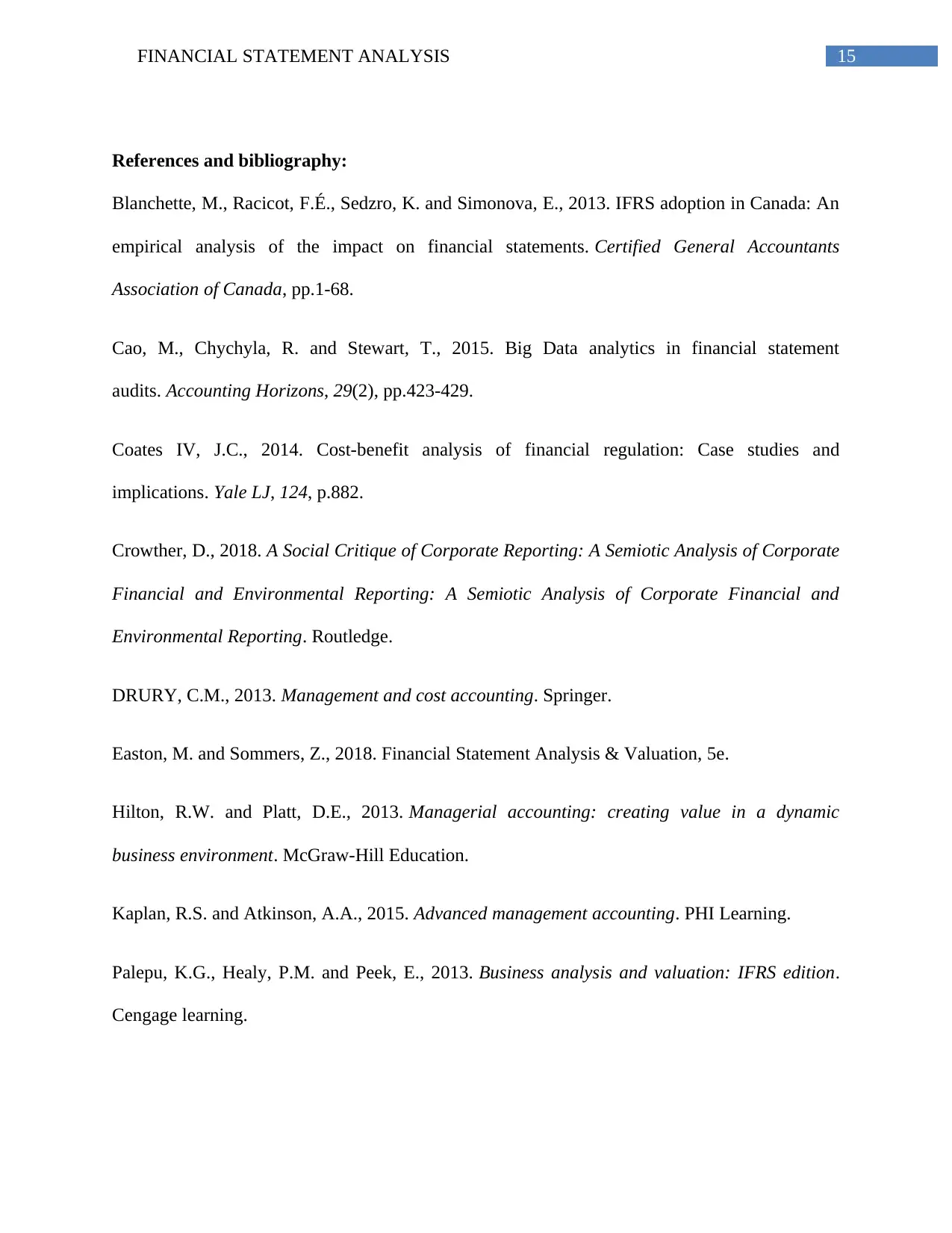
15FINANCIAL STATEMENT ANALYSIS
References and bibliography:
Blanchette, M., Racicot, F.É., Sedzro, K. and Simonova, E., 2013. IFRS adoption in Canada: An
empirical analysis of the impact on financial statements. Certified General Accountants
Association of Canada, pp.1-68.
Cao, M., Chychyla, R. and Stewart, T., 2015. Big Data analytics in financial statement
audits. Accounting Horizons, 29(2), pp.423-429.
Coates IV, J.C., 2014. Cost-benefit analysis of financial regulation: Case studies and
implications. Yale LJ, 124, p.882.
Crowther, D., 2018. A Social Critique of Corporate Reporting: A Semiotic Analysis of Corporate
Financial and Environmental Reporting: A Semiotic Analysis of Corporate Financial and
Environmental Reporting. Routledge.
DRURY, C.M., 2013. Management and cost accounting. Springer.
Easton, M. and Sommers, Z., 2018. Financial Statement Analysis & Valuation, 5e.
Hilton, R.W. and Platt, D.E., 2013. Managerial accounting: creating value in a dynamic
business environment. McGraw-Hill Education.
Kaplan, R.S. and Atkinson, A.A., 2015. Advanced management accounting. PHI Learning.
Palepu, K.G., Healy, P.M. and Peek, E., 2013. Business analysis and valuation: IFRS edition.
Cengage learning.
References and bibliography:
Blanchette, M., Racicot, F.É., Sedzro, K. and Simonova, E., 2013. IFRS adoption in Canada: An
empirical analysis of the impact on financial statements. Certified General Accountants
Association of Canada, pp.1-68.
Cao, M., Chychyla, R. and Stewart, T., 2015. Big Data analytics in financial statement
audits. Accounting Horizons, 29(2), pp.423-429.
Coates IV, J.C., 2014. Cost-benefit analysis of financial regulation: Case studies and
implications. Yale LJ, 124, p.882.
Crowther, D., 2018. A Social Critique of Corporate Reporting: A Semiotic Analysis of Corporate
Financial and Environmental Reporting: A Semiotic Analysis of Corporate Financial and
Environmental Reporting. Routledge.
DRURY, C.M., 2013. Management and cost accounting. Springer.
Easton, M. and Sommers, Z., 2018. Financial Statement Analysis & Valuation, 5e.
Hilton, R.W. and Platt, D.E., 2013. Managerial accounting: creating value in a dynamic
business environment. McGraw-Hill Education.
Kaplan, R.S. and Atkinson, A.A., 2015. Advanced management accounting. PHI Learning.
Palepu, K.G., Healy, P.M. and Peek, E., 2013. Business analysis and valuation: IFRS edition.
Cengage learning.
Paraphrase This Document
Need a fresh take? Get an instant paraphrase of this document with our AI Paraphraser
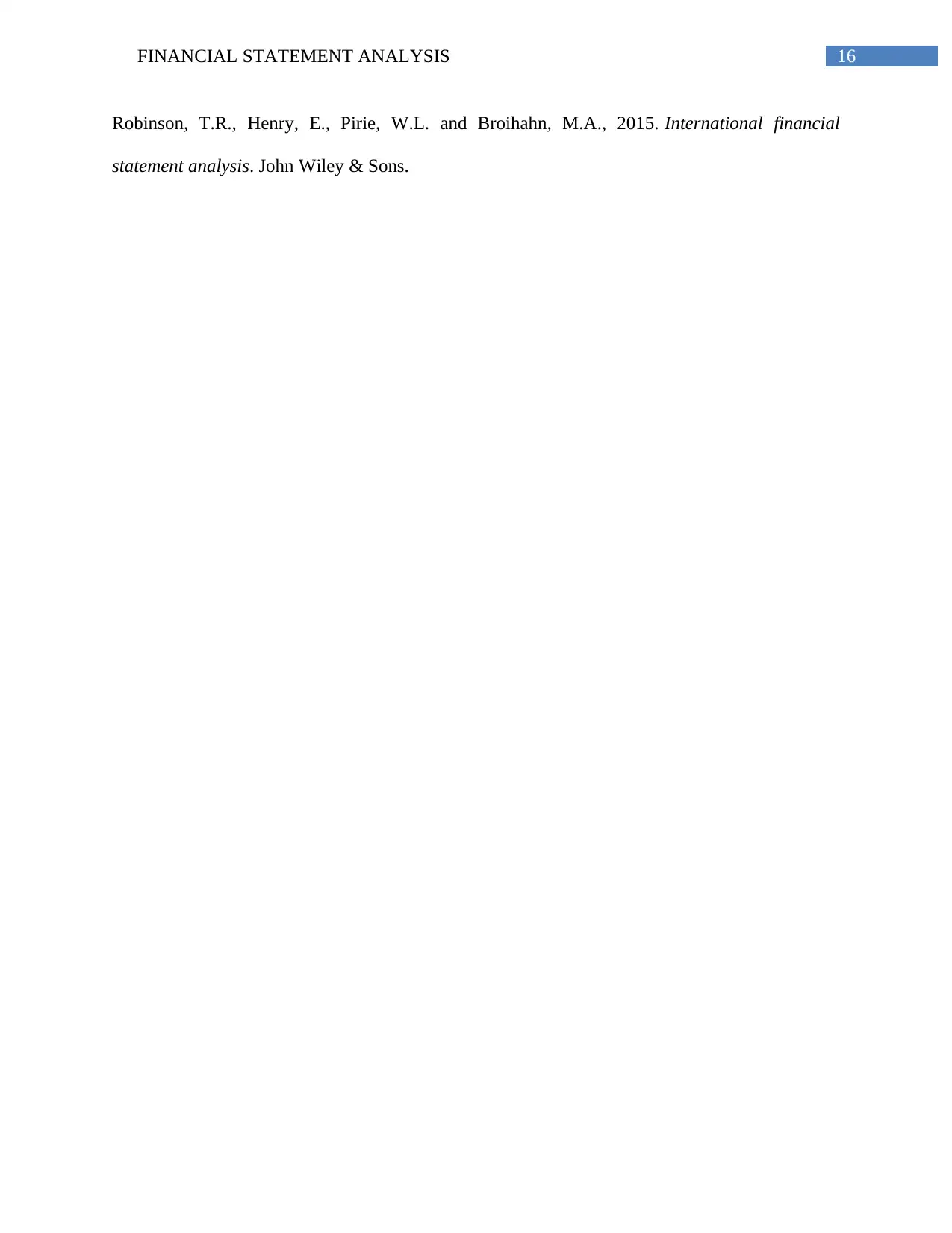
16FINANCIAL STATEMENT ANALYSIS
Robinson, T.R., Henry, E., Pirie, W.L. and Broihahn, M.A., 2015. International financial
statement analysis. John Wiley & Sons.
Robinson, T.R., Henry, E., Pirie, W.L. and Broihahn, M.A., 2015. International financial
statement analysis. John Wiley & Sons.
1 out of 17
Related Documents
Your All-in-One AI-Powered Toolkit for Academic Success.
+13062052269
info@desklib.com
Available 24*7 on WhatsApp / Email
![[object Object]](/_next/static/media/star-bottom.7253800d.svg)
Unlock your academic potential
© 2024 | Zucol Services PVT LTD | All rights reserved.





